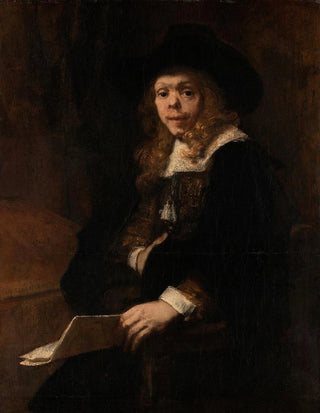Art print | Portrait of Gerard de Lairesse - Rembrandt van Rijn


View from behind

Frame (optional)
In the vibrant universe of baroque art, the encounter between light and shadow takes on an almost mystical dimension. It is within this context that the "Portrait of Gerard de Lairesse" by Rembrandt van Rijn is revealed, a masterpiece that transcends the simple frame of painting to become a true exploration of the human soul. This portrait, created in the 17th century, invites us to delve into the intimacy of a man, while offering a glimpse into the subtleties of the pictorial technique of its creator. The art print of this iconic work allows us to appreciate the depth of emotions and the richness of details, while paying homage to the artistic heritage that endures through the centuries.
Style and uniqueness of the work
The "Portrait of Gerard de Lairesse" stands out for its masterful treatment of light, an emblematic characteristic of Rembrandt. The artist skillfully plays with contrasts, illuminating the face of his subject while plunging the background into suggestive darkness. This chiaroscuro, which becomes a signature of his work, gives the composition an atmosphere that is both intimate and dramatic. The features of Gerard de Lairesse, painter and art theorist, are rendered with remarkable precision, revealing a psychological depth that attracts the viewer. The details of his attire, especially the textures of the fabrics, are also carefully crafted, demonstrating the concern for realism that characterizes Rembrandt's work. This portrait does not merely depict a man; it captures an essence, a personality, through nuances of color and plays of light that seem to vibrate on the canvas.
The artist and his influence
Rembrandt van Rijn, an emblematic figure of the 17th century, is often regarded as one of the greatest masters in the history of art. His ability to capture human emotions and explore the human condition through his works has left an indelible mark on the art world. As a painter, he was able to break free from the conventions of his time to develop a unique style that combines realism and expressionism. His influence extends far beyond his era, inspiring many artists across

Matte finish

View from behind

Frame (optional)
In the vibrant universe of baroque art, the encounter between light and shadow takes on an almost mystical dimension. It is within this context that the "Portrait of Gerard de Lairesse" by Rembrandt van Rijn is revealed, a masterpiece that transcends the simple frame of painting to become a true exploration of the human soul. This portrait, created in the 17th century, invites us to delve into the intimacy of a man, while offering a glimpse into the subtleties of the pictorial technique of its creator. The art print of this iconic work allows us to appreciate the depth of emotions and the richness of details, while paying homage to the artistic heritage that endures through the centuries.
Style and uniqueness of the work
The "Portrait of Gerard de Lairesse" stands out for its masterful treatment of light, an emblematic characteristic of Rembrandt. The artist skillfully plays with contrasts, illuminating the face of his subject while plunging the background into suggestive darkness. This chiaroscuro, which becomes a signature of his work, gives the composition an atmosphere that is both intimate and dramatic. The features of Gerard de Lairesse, painter and art theorist, are rendered with remarkable precision, revealing a psychological depth that attracts the viewer. The details of his attire, especially the textures of the fabrics, are also carefully crafted, demonstrating the concern for realism that characterizes Rembrandt's work. This portrait does not merely depict a man; it captures an essence, a personality, through nuances of color and plays of light that seem to vibrate on the canvas.
The artist and his influence
Rembrandt van Rijn, an emblematic figure of the 17th century, is often regarded as one of the greatest masters in the history of art. His ability to capture human emotions and explore the human condition through his works has left an indelible mark on the art world. As a painter, he was able to break free from the conventions of his time to develop a unique style that combines realism and expressionism. His influence extends far beyond his era, inspiring many artists across






